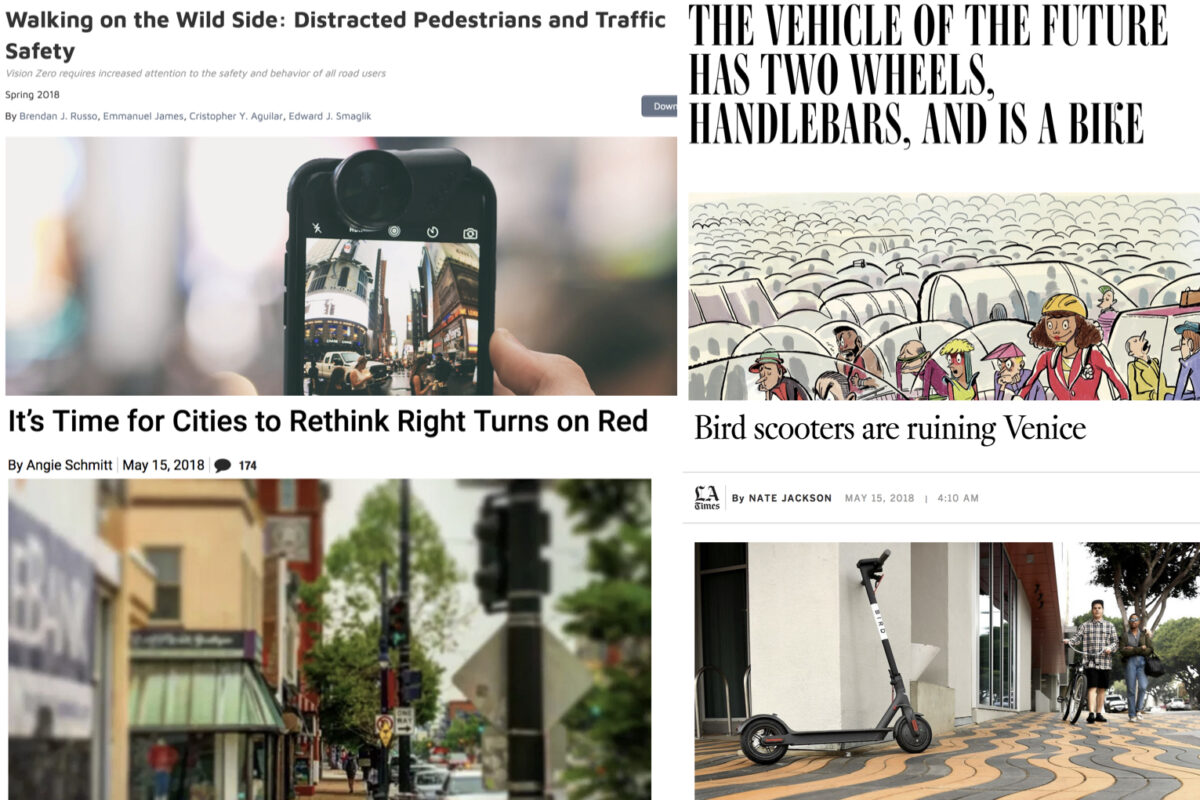
Welcome to Monday.
Here are the best stories we came across in the past seven days…
Leveling the mobility playing field: People who struggle to make ends meet face a major barrier without access to quality transportation — and Trump’s welfare plan does nothing to change that.
Bike tech: Wired Magazine reminds us that more driving won’t save us and bicycles are all the transportation technology cities need.
3D printed bike: A Silicon Valley startup is showing off what they say is the world’s first carbon fiber bike printed by a computer. The firm has funding from a firm that is backed by the Central Intelligence Agency.
Another one: It’s downright disgusting that U.S. regulators allow a private company to let people drive “automated” cars in the public right-of-way. We’re going to see many more crashes like this one. We should be making cars that require more engagement from drivers, not less.
Scooter hater: A former NFL player penned an op-ed for the L.A. Times denouncing the scourge of dockless scooters in Venice.
Scooting right along: The author of that op-ed will not be happy to hear that Lime (a company with a strong interest in the Portland market) recently raised $500 million to build up its dockless scooter war chest.
Right turns on red is just wrong: Streetsblog explains how right-turns-on-red — a nemesis of safe streets advocates — was mandated by the federal government as a gas-saving measure in the 1970s. “It’s just another example where we prioritize mobility over safety.”
Advertisement
Better ways, indeed: It’s very heartening to see ideas like human-scale streets, decongestion pricing, and the lessons of global cities like London and Copenhagen get prominently espoused in the NY Times op-ed pages.
Detroit’s adaptive bike share: The Motor City has a new program to make adaptive bikes like trikes and handcycles more easily available through their existing bike share program.
Sorry, millennials are addicted to driving too: New research appears to upend a common narrative from the past few years that millennials care less for driving and suburbs than other generations. “In a nutshell, we found little evidence of a substantial cultural turn by millennials away from cars and suburbs.”
The facts behind “distracted pedestrians”: We’ve all see the anti-walking propaganda about “petextrians” and the like, now someone has actually done research on the topic. And guess what? It appears people aren’t as distracted while walking as DOTs and mainstream media like to think.
Take heed, PBA: A Manhattan business association (backed by developers and local elected officials) is advocating for more carfree space and “shared streets” in the financial district.
It’s the culture, stupid: Glad to hear the radical (sarcasm) idea that people just need to chill the f*&# out while behind the wheel getting attention thanks to former Toronto city planner Jennifer Keesmaat.
Drive safely, help your neighborhood: Modacity flagged this amazing story from the Netherlands about an electronic speedometer that puts money into a fund for a local playground if people drive at or below the speed limit. Brilliant!
— Jonathan Maus: (503) 706-8804, @jonathan_maus on Twitter and jonathan@bikeportland.org
Never miss a story. Sign-up for the daily BP Headlines email.
BikePortland needs your support.


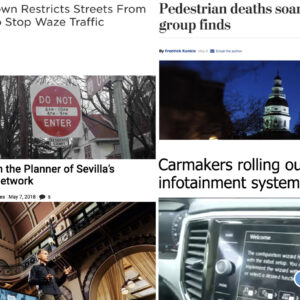
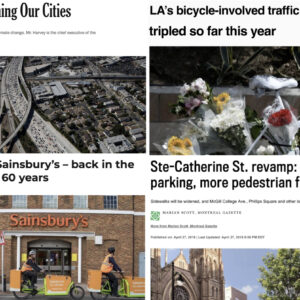
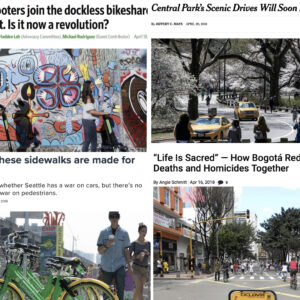
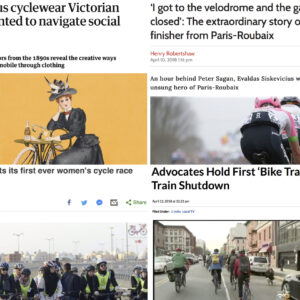
Thanks for reading.
BikePortland has served this community with independent community journalism since 2005. We rely on subscriptions from readers like you to survive. Your financial support is vital in keeping this valuable resource alive and well.
Please subscribe today to strengthen and expand our work.
Right on red – Streetsblog is correct that it became popular in the 70’s as a ‘fuel economy’ measure; nevertheless, it was never adopted by NYC, for all the usual safety reasons.
Right on red increases conflict — especially in places where it’s sometimes prohibited and sometimes allowed such as at Oregon and Interstate. Such conflicts are relatively common.
However, conflict resulting from cyclists passing on the right of vehicles turning right with the light is even more common. I suspect that is because even though too many motorists fail to check for peds who might be crossing with a walk signal right in front of them, even more fail to check (or in some cases see) cyclists coming up from behind.
Despite the very real problems that it creates, I prefer allowing turning on red. When drivers get trapped behind too many light cycles, their behavior gets progressively more erratic and dangerous and their attention and interaction with other road users deteriorates rather than improves despite the fact that they’re going nowhere or moving very slowly.
Note that left on red is also allowed in Oregon if onto a one way street.
While I agree that being stuck in traffic is one of the many things that motorists use as an excuse for their uncivilized behavior, I still favor doing away with right on red. I strongly feel that once traffic gets to a critical level of frustration, some folks will realize that it is simply better to get out of the driver’s seat. If we add bus-only lanes (so they see buses zipping past them), it might even happen quicker.
As more former motorists discover other means of getting around, it can’t help but have a civilizing effect on the ones who remain in cars since they will be that much more likely to know someone who is using transit, walking or cycling. At least I hope it works that way.
The two jurisdictions I know of that never permitted right on red were the most opposite you could imagine: NYC and North Dakota.
I got to the opening line of the LA Times piece: “I am certain that people who ride Bird scooters don’t read newspapers, ” and didn’t even finish reading the sentence, let alone the rest of the article.
it gets a little better. I’m not on board with his whole program, but he has some legitimate grievances, mostly with tech companies’ antisocial behavior.
yeah. it seemed strange that he lead a piece about bad corporate behavior by picking a fight with scooters, which I would certainly rather there be more of than cars even if there are some downsides (and clearly, there are).
That printed frame has no seatstay. In its place, there are not-quite-parallel chainstays. I’m not a mechanical engineer, but it looks like something would snap at the first big curb or pothole. Any engineers around to comment on that?
It appears that this is a feature to allow for the use of a belt drive. Since a belt drive cannot be broken like a chain for installation the frame must allow for a way to install a belt. The lack of a seat stay is much less efficient from a weight and strength standpoint but if you can always make the chainstays strong enough by adding more material. It is not much different than an aircraft wing.
Given that a 3D print can do whatever cross section you want, the chainstays can be incredibly stiff, the way the frame is setup.
It doesn’t look too much different than a full suspension xc bike, but with rigidly mounted stays (no linkages)
Not an engineer, but there’s no reason this can’t be valid if designed properly — for an extreme example, you wouldn’t be questioning the strength if it was solid steel even if that would result in an unacceptably heavy frame.
Things that don’t look strong/symmetrical can be. For years, you can get bikes with single sided forks — this allows you to do things like changing the tire without removing the wheel (kind of nice with discs). You’ll also notice that aircraft wheels have this design.
They don’t mention if this is actually lighter than a “traditional” design — and it might not be. The interesting thing is that it’s a cheap way to make pretty light frames. Not sure why they mention the CIA angle — as if that agency doesn’t blow all kinds of dough on things that don’t work.
Regarding the Tesla crash… Autopilot is dangerous precisely because it requires human engagement. This is why most other companies are eschewing human interaction, and are going for full automation. Using the word “disgusting” shows you have stronger feelings about this issue than the facts would merit.
Agreed. Tesla is, IMHO, trying to have it both ways right now. On the one hand they know their autonomous tech isn’t level 5 yet, so all the legal trappings (plus some built-in reminders) are in place to assert that drivers must remain engaged and in control. On the other, they call it “Autopilot,” and people are definitely prone to just turn the driving over to the car.
I’m not sure a study has concluded that Autopilot is safer than a human driver, yet, once all the variables are accounted for but it’s a long way from “disgusting.” Autopilot hasn’t killed anyone but the car’s occupants yet, and even those are uncommon. What’s more, every one of those that’s analyzed and fixed is fixed for *everyone.*
It’s not the only solution or a complete solution, but it’s bound to help.
I agree, allowing rich stupid people to act as the guinea pigs to test out a half-baked version of auto self driving seems more ironic than disgusting. But if you saw the crash site where the person in Switzerland roasted themselves depending on the self driving feature in a model S ( after this fire truck rear end incident) disgusting might come to mind.
Disgusting, yes, but surely not more disgusting than the fallout from a standard car crashing at that speed?
The real problem is that the Tesla does NOT have a self-driving system.
I love the Dutch timing camera idea–it could be used, in the US, to fund police auto theft details. If drivers behave, the city will protect their property. If they don’t…………………
I was passed by a Washington County Sheriff on Hwy 26 this weekend who was driving at least 15 or 20mph over the speed limit, and tailgating people to get them to move out of the left lane. It wasn’t abnormal in any way.
Sorry to comment late, but this is not necessarily as unreasonable as it may seem. I don’t know about WaCo, but many departments have requirements that prohibit driving code 3 (lights + sirens) unless life is at risk. There are many situations that demand an urgent response but don’t rise to the level of justifying code 3.
https://www.huffingtonpost.com/william-morrow/a-look-at-how-housing-pre_b_10354666.html
“you’ll find some similarities in preferences among the generations with all generations preferring a single family detached home.”
“the generations also agree on the aspect of location as the majority of home buyers don’t want to live in city centers. The majority of home buyers today prefer homes in the suburbs especially the millennial generation.”
“Many new home builders such as Legend Homes in Houston, TX report that a large percentage of their home sales over the past two years have been to millennials moving out of city centers and establishing roots in new home communities in the suburbs”
https://www.nahbclassic.org/generic.aspx?genericContentID=249797
“The majority of buyers (65%) would like to buy a single-family detached home. A majority of buyers in all generations have the same preference: Millennials (68%), Gen X (72%), Boomers (63%), and Seniors (55%).”
“Buyers want a home with a median 2,020 square feet of finished area, about 9 percent larger than they have now. Millennials and Gen X’ers want over 2,300 square feet; Boomers and Seniors less than 1,900 square feet.”
http://www.businessinsider.com/how-millennials-are-changing-the-housing-market-infographic-2017-7
It seems too soon for the pendulum to be swinging again. Do we need to start talking about “modern suburbanism”? (Folks, you heard it hear first!)
My suspicion is that millennial’s, like other generations before them, were happy to live in a small downtown apartment when single and/or child free, but when they start having kids, practical issues like a safe backyard for the kids to play in, and a halfway decent school system become higher priorities than access to hip restaurants and bars.
In the anti-scooter opinion piece it is not exactly clear what these scooters are being used for. Are the tech company employees riding from their nearby homes in Venice ( doubtful) or are they riding them from big municipal parking garages in Venice or Santa Monica that they commute to from far away. Or do they just hop on at lunch time and zip around the area terrorizing the locals on the way to find lunch?
Also Lyft may get into the scooter biz – https://techcrunch.com/2018/05/21/lyft-electric-scooter-san-francisco/
Like many things this is the result of parenting. I taught my kids that driving cars was the societal version of doing crack or meth. It’s easy and feels good when you do it but leads to death and destruction later. As a result both of them are in their late 20’s , live on their own and don’t own or drive cars.
Enjoyed the Wired article, and I think there’s a lesson there for Portland City Hall. With all the talk about being on the forefront of “smart cities” and autonomous vehicles, it seems like City Hall (and ODOT) could be laying the ground work for mass adoption of dockless e-bikes. Specifically, a robust network of protected bike lanes in transportation corridors which will foster adoption of bicycling (for commutes, running errands, whatever) of the interested but concerned.
i saw a huge numbers of e-bikes on the sun parkways loop. a very positive development, imo.
I rode my ebike the whole route without switching it on.
Yes Streetsblog is correct…I remember the era before RTOR and its final adoption as I was starting to drive.
This topic may be a great mini-project for a PSU transportation or pre-law student to research…given that its adoption may have been an “emergency” measure with a sunset or other streamlined adoption step that may make it easier to terminate at the state or local level.
NTOR / RTOR:
2005 Minnesota study: http://www.ci.minneapolis.mn.us/www/groups/public/@council/documents/webcontent/convert_269673.pdf
Connecticut and US History:
https://www.cga.ct.gov/ps99/rpt/olr/htm/99-r-1021.htm
Minneapolis has been very aggressive over the last couple of decades in banning RTOR on an intersection-by-intersection basis. I frequently encounter intersections with NTOR signs, even when the sightlines don’t appear to be that bad, but appear to have high crash rates generally.,
That said, the signs are generally ignored. Minnesota drivers seem to view RTOR as a birthright. They will blast into a crosswalk expecting to make a RTOR, even as far as breaking the inner plane of the intersection and obstructing the parallel bike lane, even when there are clearly pedestrians approaching in the crosswalk. This is part of the general blatant disregard for pedestrians prevalent among Minnesotans.
I ignorantly bought a house in the burbs before I realized how much I would rather walk and bike places. Now that we have a kid it’s nice being at least on the same side of the metro area as grandparents and I have grown to appreciate the calm neighborhood we live in. But I hate how my wife is pretty much forced to drive places and that we are seen as a novelty riding our bikes as a family. As much as I would enjoy some aspect of living in town other aspects of it would be much harder for us as a family and we may end up driving more being further away from work / childcare / family.
Don’t mistake people that live in the suburbs as enjoying it and that they have resigned to being car dependent. I hope there are more young families like me than I think and we can change things out here.